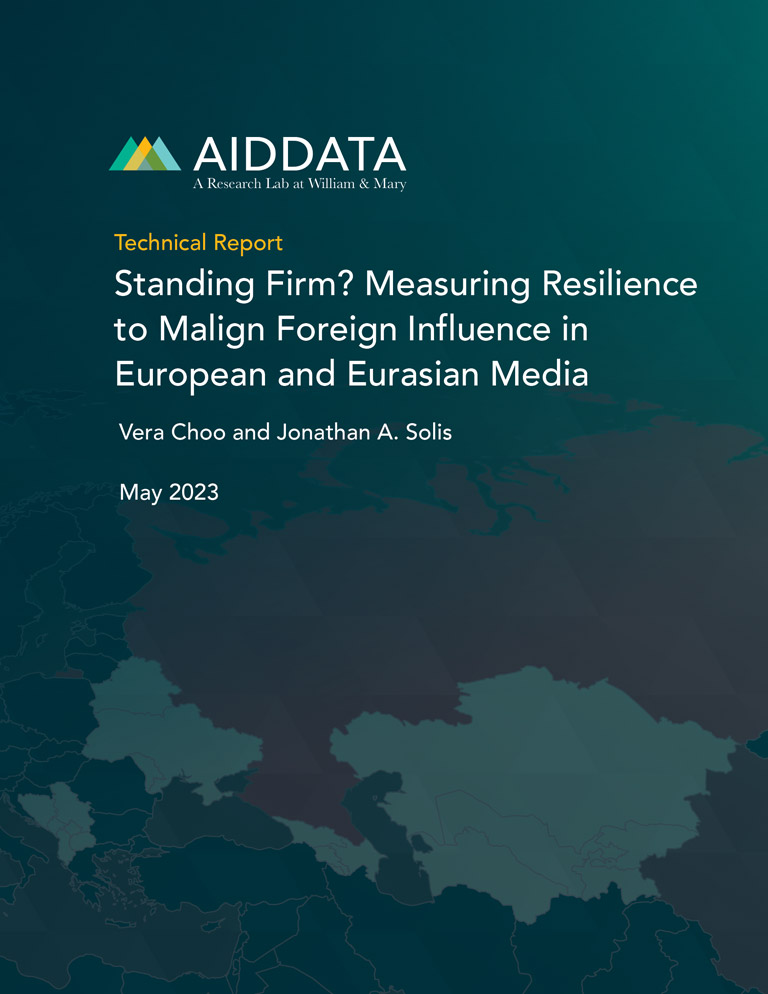Media Resilience in Eastern Europe & Eurasia
Understanding the media's vulnerability to malign foreign influence
Overview
Countries in Eastern Europe & Eurasia are experienced increasing efforts on the part of malign foreign actors to influence their media. AidData has developed a suite of tools to better understand the resilience of the region's media landscape in the face of these influence efforts.
We have conceptualized and quantified media resilience in a new regional index; identified the ownership of top media outlets and the presence of Russian state-run media across 17 countries; measured the sentiment of news content; and evaluated media literacy among citizens. These tools provide policymakers, practitioners, and scholars with better data to assess possible pathways for malign foreign influence of local media narratives and understand Russia's activities in the region.
For partnerships and media queries, contact:

Alex Wooley
Director of Partnerships and Communications
Regional Spotlight: Europe & Eurasia
What are the points of vulnerability and resilience of domestic media environments to foreign malign influence?
AidData researchers sought to answer this question in Eastern European and Eurasian countries that have not yet joined the European Union (EU). These 17 countries sit at the crossroads of Russia’s sphere of influence and Western organizations like the EU and the North Atlantic Treaty Organization (NATO). Some are full or associate members of the Commonwealth of Independent States, a Russia-dominated intergovernmental organization, while others are NATO members and remain EU candidates or potential candidate countries.
Media resilience is one of three AidData focus areas in the region. Learn more about our research on civic space and energy security.

A Deep Dive into Media Resilience
Media Resilience Index
AidData researchers measured three key dimensions of resilience: (1) journalists and the media as content suppliers; (2) citizens as consumers of that information; and (3) government institutions as regulators. The resulting Media Resilience to Malign Influence (MRMI) index, featured in the Standing Firm? Measuring Resilience to Malign Foreign Influence in European & Eurasian Media report, incorporates data collected on each of these three components for 17 countries from 2010-2020 and provides a composite score, facilitating cross-comparability over time.
Media Ownership Country Reports
Across 17 countries, AidData researchers have mapped media ownership and potential channels for foreign influence. Each country profile features a list of the top five radio, TV, newspaper and online outlets, plus a breakdown of corporate and individual shareholders that highlights ownership ties to both domestic governments and foreign entities, including the Kremlin and Russian oligarchs. The profiles also track the presence of 11 Russian state-owned media outlets, including Russia 1, RTR-Planeta, TASS and Sputnik.
Media Literacy Survey Report
AidData researchers fielded a digital survey in 10 of the 17 E&E countries that asked 35 questions evaluating media literacy. If governments and media are captured by foreign actors, the last line of defense are citizens and their ability to identify and reject (or not) dis- and misinformation. AidData partnered with survey firm RIWI to leverage their novel Random Domain Intercept Technology to field the survey online, which mixed self-reporting questions about behavior and “right and wrong” questions to provide objective tests.
Media Sentiment Analysis
Utilizing the top online outlets in the media ownership profile, AidData researchers scraped as many articles as possible to conduct sentiment analysis on keywords to indicate how favorably or not topics from the West, Russia, and even China were covered from 2019 to 2021.



























